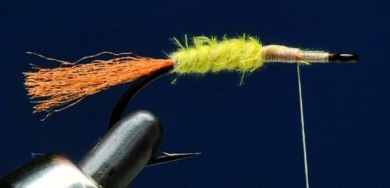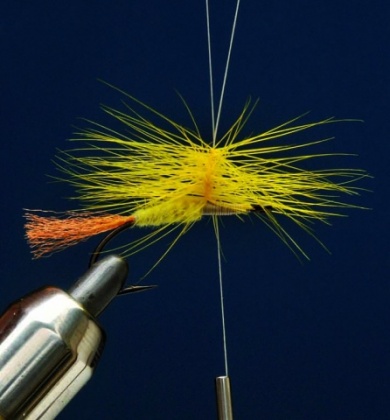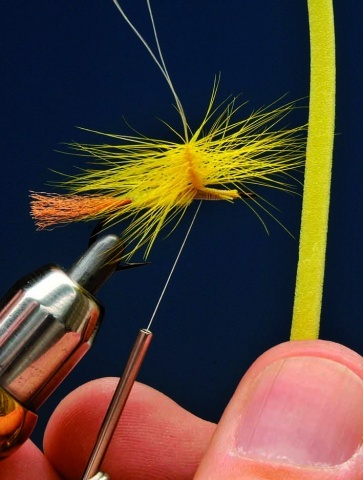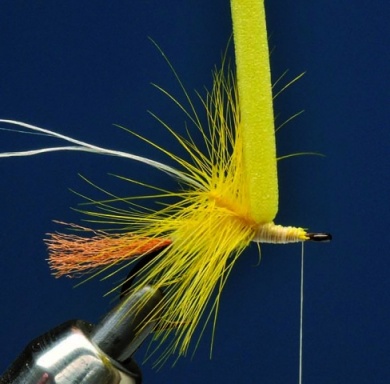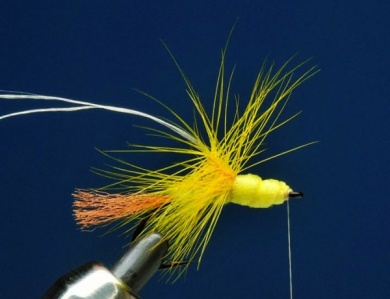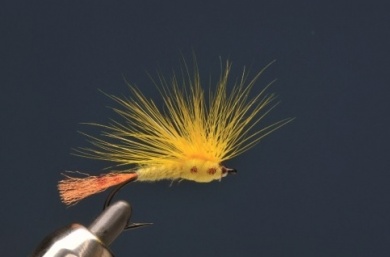For many years mayflies have been taken for hexs, but these are not related, they only have similar sizes in the adult stage. Chiloporter nymphs are skilled swimmers that live close to the shore in fast waters of streams and rivers. You can find these almost throughout all Argentinean and Chilean Pa View more...For many years mayflies have been taken for hexs, but these are not related, they only have similar sizes in the adult stage. Chiloporter nymphs are skilled swimmers that live close to the shore in fast waters of streams and rivers. You can find these almost throughout all Argentinean and Chilean Patagonia.These are predatory nymphs that feed on other nymphs and reach good sizes. Their emergence happens in the last moments of light of the day and during the night, so it is hard to be able to enjoy them. Feminine adult insects are bigger than the males, and have a darker yellow color during its dun stage. When they become spinners, the color turns paler, almost beige, with brown spots at the sides. We find these flies during summer afternoons but the hatches are not that often, at least that is what we can observe in Patagonia, in the Junín de los Andes area.Early during the hatch or before it, big nymphs like the Montana and the Bitch Creek are really effective, but right before trout start feeding on the adults is the right time for the emerger. They tend to take longer before feeding on the adults, and the emergent –a cross between nymph and adult- works really well.The M.M. Chiloporter Emerger came from several tests, until I got one that trout really liked. Sometimes, a yellow marabou tail works better than antron in slow waters. The foam thorax makes it float correctly and improves the silhouette of the fly when seen from below, especially with a clear sunset sky. Remember to use a thicker tippet, at least 3X, if you don't want to experience losing a fish.
Move the mouse over the image to zoom in the fly.
Touch the image to zoom in the fly.

List of materials
Tying MaterialsHook: I like to use elegant classic ones for this fly. Partridge for its quality and refined design. I use the models Klink-Hammer or YK12ST, sizes 12 or 14.Thread: Fine, white color. It can be 6/0, 8/0 or 14/0.Tail: (It resembles the empty cuticle of the nymph) mid Brown color Antron and some yellow marabou.Abdomen: big yellow CDC feather.Wings and legs: yellow rooster feather and transparent nylon of 0,10 mm.Thorax: yellow foam strap (Evazote), 3 mm thick. View more...Tying MaterialsHook: I like to use elegant classic ones for this fly. Partridge for its quality and refined design. I use the models Klink-Hammer or YK12ST, sizes 12 or 14.Thread: Fine, white color. It can be 6/0, 8/0 or 14/0.Tail: (It resembles the empty cuticle of the nymph) mid Brown color Antron and some yellow marabou.Abdomen: big yellow CDC feather.Wings and legs: yellow rooster feather and transparent nylon of 0,10 mm.Thorax: yellow foam strap (Evazote), 3 mm thick.
Steps
Step 1
Neatly tie an antron strap up to the hook bend. You can replace antron with yellow marabou fibers or fibers from the feather to use for the hackle (the spongy part is good). This is good for slow waters and below tree branches.
Step 2
Tie a long yellow CDC feather. It´s important to use a thick raquis, and correct length feather so as to shape the abdomen. The CDC feathers come in several sizes and purposes. Take the feather by its thicker tip with a hackle pliers and wrap it around itself, as we do the same with the hook shank. The feather should make an abdomen that covers half the shank. Trim the loose feather fibers, I tend to leave them because they give life to the fly but the picture shows no fibers so it´s clearer. View more...Tie a long yellow CDC feather. It´s important to use a thick raquis, and correct length feather so as to shape the abdomen. The CDC feathers come in several sizes and purposes. Take the feather by its thicker tip with a hackle pliers and wrap it around itself, as we do the same with the hook shank. The feather should make an abdomen that covers half the shank. Trim the loose feather fibers, I tend to leave them because they give life to the fly but the picture shows no fibers so it´s clearer.

Step 3
With a 0,10 mm (max.) monofilament make a loop and tie it firmly up to the abdomen. It shoud not be more than 6 cm high so the loop remains tidy when we wrap the feather, and turn it without losing tension.
Step 4
Select a quality saddle hackle feather, dyed bright yellow, with long fibers. The hackle will resemble the legs and wings, if it´s longer it´s better. The left side of the feather should be tidier and thin, the most colorful side should point towards us. The concave part points to the back and down when we tie the feather on the loop.
Step 5
Hold the loop tight with your index finger and wrap the feather. Make a half a turn and hold the feather with your thumb and middle finger of your left hand, as you grab it again and do another turn with the right hand. If the raquis is too dry, wet it with warm water to loosen it a bit.
Step 6
Tie the feather upwards and then downwards, tying it with the thread when you get to the hook shank. We should get a hackle on the loop, 1 mm longer than the thorax.
Step 7
Tie an Evazote strap of 3 mm. Eva foam if not or even with yellow dubbing, to make the thorax. Firmly tie the foam until setting it on the abdomen, lifting and combing the hackle towards the back as we keep the loop tight.
Step 8
Shape the thorax with two foam turns, tying it at the back of the hook eye and trimming.
Step 9
Holding the loop tight, comb the hackle to the back, set it on the thorax neatly and making a 180° shape.
Step 10
Tie the monofilament, first to the front and then to the back, and trim. Some cianoacrylate is highly recommended.
Step 11
Finally, paint some brown marks with permanent marker. The MM Chiloporter Emerger is now ready to give us surprises.



